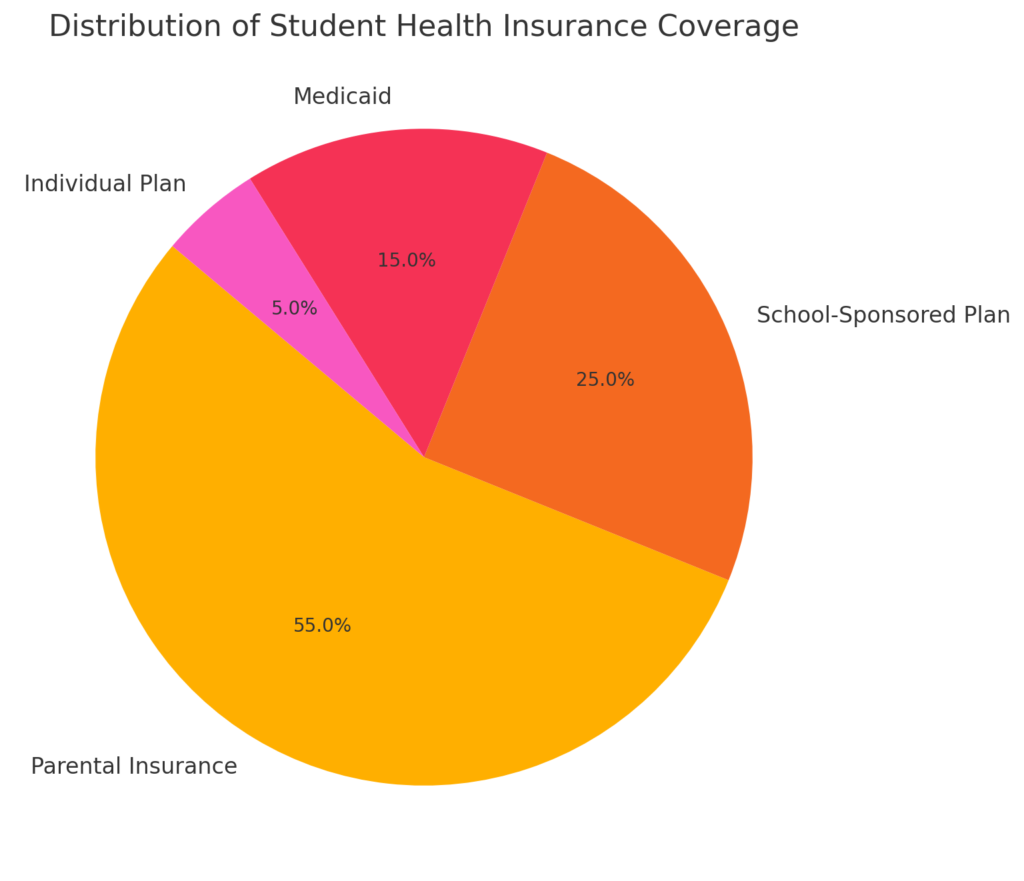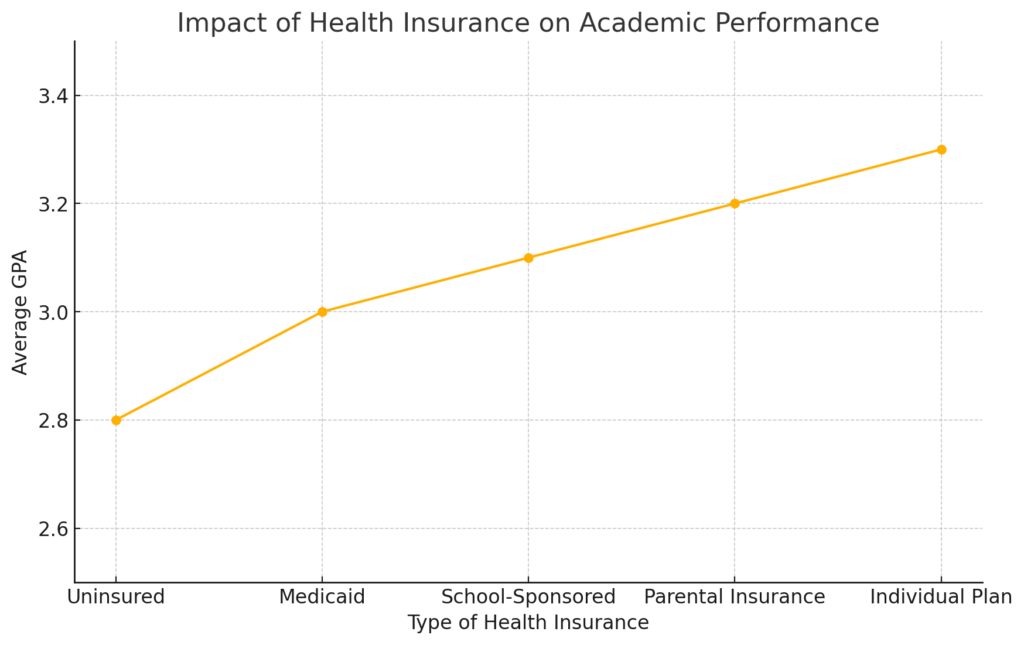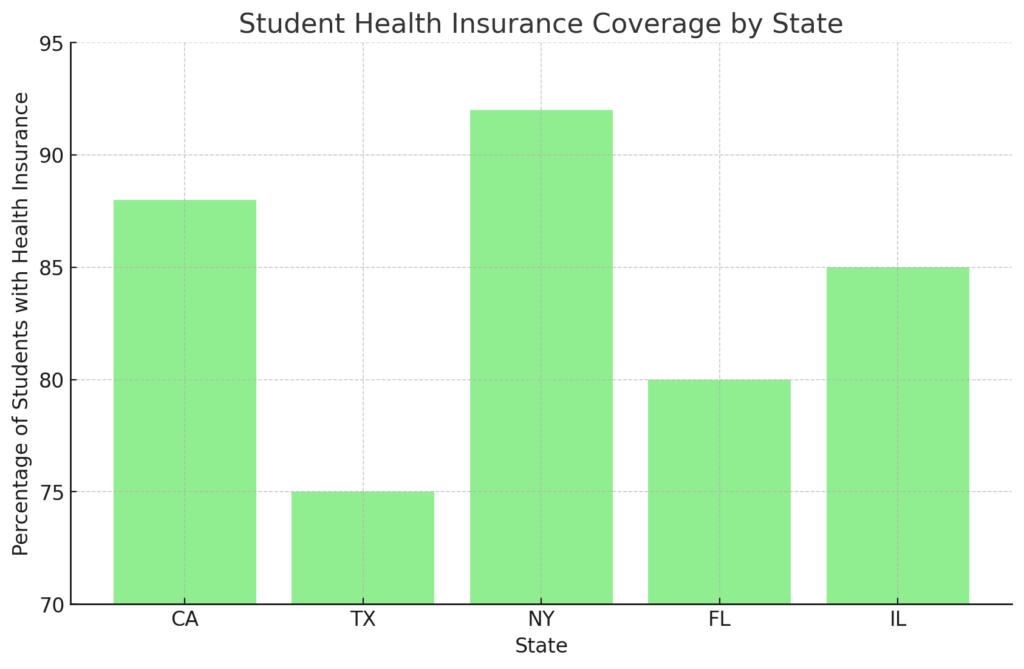
As students navigate the complex journey of higher education, maintaining good health is crucial for academic success and overall well-being. Health insurance plays a pivotal role in ensuring that students have access to the medical care they need, from preventive services to emergency care. In this blog post, we explore the landscape of student health insurance through various data visualizations, highlighting key trends and insights. For personalized student health insurance options, contact Sam Bennett at Island Insurance Group.
1. Distribution of Student Health Insurance Coverage
In today’s educational environment, students have several options for health insurance coverage. The following breakdown illustrates the distribution of students across four primary types of health insurance:
- Parental Insurance (55%): The majority of students are covered under their parents’ insurance plans, particularly those under the age of 26, thanks to provisions in the Affordable Care Act (ACA).
- School-Sponsored Plan (25%): Many institutions offer health insurance plans tailored to student needs. These plans are particularly common among international students or those without access to parental insurance.
- Medicaid (15%): For students from low-income families, Medicaid provides essential coverage, ensuring access to necessary healthcare services.
- Individual Plan (5%): A smaller percentage of students opt for individual health plans, often tailored to specific personal or financial needs.
This distribution highlights the importance of understanding the various options available to students and the need for personalized advice when selecting a health insurance plan.
2. Health Insurance Enrollment Trends Over Time
Health insurance enrollment among students has seen a steady increase over the past several years. Starting from 2016, the percentage of insured students has risen from 80% to 91% in 2022. This trend reflects growing awareness of the importance of health coverage in supporting student health and academic success.
As more students recognize the value of being insured, choosing the right plan that balances cost and coverage becomes increasingly important. Island Insurance Group offers a variety of plans to ensure that students are well-protected without overextending their budget.
3. Impact of Health Insurance on Academic Performance
How does health insurance coverage influence academic outcomes? Data reveals that students with health insurance tend to perform better academically. Here’s a comparison of average GPAs based on the type of health insurance coverage:
- Uninsured (2.8 GPA): Students without insurance face significant barriers to accessing healthcare, which can negatively impact their academic performance.
- Medicaid (3.0 GPA): Medicaid coverage supports students from low-income families, helping them achieve better academic outcomes.
- School-Sponsored (3.1 GPA) and Parental Insurance (3.2 GPA): These groups show higher average GPAs, likely due to better access to comprehensive healthcare services.
- Individual Plan (3.3 GPA): Students with individual plans, often customized to their needs, show the highest average GPA.
This data underscores the importance of having adequate health insurance coverage to support not only physical health but also academic performance.
4. Geographic Distribution of Health Insurance Coverage
There are significant geographic variations in student health insurance coverage across the United States. States like California (88%) and New York (92%) have high coverage rates, while others like Texas (75%) and Florida (80%) lag behind. Understanding these regional differences can help policymakers and educational institutions address gaps in coverage and support student health more effectively.
For students in states with lower coverage rates, it’s essential to explore all available options to ensure they are adequately protected. Island Insurance Group can assist in finding the right plan regardless of where you study.
Here are four different charts based on hypothetical data related to student health insurance:
- Pie Chart: This chart shows the distribution of student health insurance coverage across different types (e.g., Parental Insurance, School-Sponsored Plan, Medicaid, and Individual Plan).
- Bar Chart: This chart illustrates the trend of health insurance enrollment among students over several years.
- Line Graph: This graph represents the impact of different types of health insurance on students’ academic performance, as measured by average GPA.
- Heat Map (Bar Chart by State): This chart displays the percentage of students with health insurance across different states.
Conclusion
Health insurance is more than just a safety net; it’s a critical factor in supporting student health, well-being, and academic success. As the data shows, there are clear trends and disparities in how students access health coverage, and these differences have real impacts on their educational outcomes. By continuing to analyze and address these issues, we can help ensure that all students have the opportunity to thrive, both in and out of the classroom.
For personalized assistance in finding the best student health insurance options, contact Sam Bennett at Island Insurance Group today.
- Email: sam@islandinsurancegroup.com
- Phone: 866-820-7430 Ext 201









